Spatial Gradient Differences in the Cooling Island Effect and Influencing Factors of Urban Park Green Spaces in Beijing
Abstract
:1. Introduction
2. Materials and Methods
2.1. Study Area
2.2. Data Sources
2.3. Calculation of Park Cool Island Intensity
2.4. Calculation of Relevant Characteristic Indicators of Park Green Spaces
2.5. Statistical Analysis
3. Results
3.1. Characteristics of Park Green Spaces across Different Spatial Gradients
3.2. Characteristics of the UHI Effect across Different Spatial Gradients
3.3. Characteristics of Park Green Space Cold Island Effect across Different Spatial Gradients
3.4. Factors Influencing the Cold Island Effect of Urban Park Green Spaces across Different Spatial Gradients
4. Discussion
4.1. The Impact of Spatial Gradients on Urban Park Green Space Cold Island Effect
4.2. Spatial Gradient Differences in the Relationship between Urban Park Green Space Characteristics and the UHI Effect
4.3. Different Regions Require Tailored Strategies for Optimizing and Managing Urban Park Green Spaces
5. Conclusions
Author Contributions
Funding
Data Availability Statement
Conflicts of Interest
References
- Dong, X.; Meng, Z.; Wang, Y.; Zhang, Y.; Sun, H.; Wang, Q. Monitoring Spatiotemporal Changes of Impervious Surfaces in Beijing City Using Random Forest Algorithm and Textural Features. Remote Sens. 2021, 13, 153. [Google Scholar] [CrossRef]
- Hendel, M.; Azos-Diaz, K.; Tremeac, B. Behavioral adaptation to heat-related health risks in cities. Energy Build. 2016, 152, 823–829. [Google Scholar] [CrossRef]
- Levermore, G.; Parkinson, J.; Lee, K.; Laycock, P.; Lindley, S. The increasing trend of the urban heat island intensity. Urban Clim. 2018, 24, 360–368. [Google Scholar] [CrossRef]
- Halder, B.; Bandyopadhyay, J.; Banik, P. Evaluation of the Climate Change Impact on Urban Heat Island Based on Land Surface Temperature and Geospatial Indicators. Int. J. Environ. Res. 2021, 15, 819–835. [Google Scholar] [CrossRef]
- Kamal, A.; Mahfouz, A.; Sezer, N.; Hassan, I.G.; Wang, L.L.; Rahman, M.A. Investigation of urban heat island and climate change and their combined impact on building cooling demand in the hot and humid climate of Qatar. Urban Clim. 2023, 52, 101704. [Google Scholar] [CrossRef]
- Yang, X.; Chen, B.; Hu, K. A Review of Impacts of Urbanization on Extreme Heat Events. Prog. Geogr. 2015, 34, 1219–1228. [Google Scholar]
- Eugenia, K.; Ming, C. Impact of Urbanization and Land-use Change on Climate. Nature 2003, 423, 528–531. [Google Scholar]
- Yu, Z.; Guo, Q.; Sun, R. Impacts of Urban Cooling Effect Based on Landscape Scale: A Review. J. Appl. Ecol. 2015, 26, 636–642. [Google Scholar]
- Gao, Z.; Zaitchik, B.F.; Hou, Y.; Chen, W. Toward park design optimization to mitigate the urban heat Island: Assessment of the cooling effect in five U.S. cities. Sustain. Cities Soc. 2022, 81, 103870. [Google Scholar] [CrossRef]
- Wang, X.; Kong, F.H.; Yin, H.; Xu, H.; Li, J.; Pu, Y. Characteristics of Vegetation Shading and Transpiration Cooling Effects During Hot Summer. Acta Ecol. Sin. 2018, 38, 4234–4244. [Google Scholar]
- Du, H.; Song, X.; Jiang, H.; Kan, Z.; Wang, Z.; Cai, Y. Research on the Cooling Island Effects of Water Body: A Case Study of Shanghai, China. Ecol. Indic. 2016, 67, 31–38. [Google Scholar] [CrossRef]
- Hien, W.; Liang, T.; Denia, K.D.; Hideki, T. Greenery as a Mitigation and Adaptation Strategy to Urban Heat. Nat. Rev. Earth Environ. 2021, 2, 166–181. [Google Scholar]
- Feyisa, G.L.; Dons, K.; Meilby, H. Efficiency of Parks in Mitigating Urban Heat Island Effect: An Example From Addis Ababa. Landsc. Urban Plan. 2014, 123, 87–95. [Google Scholar] [CrossRef]
- Yue, X.; Lin, J.; Yang, Y. Mitigation Role of Urban Green Space in Reducing Heat Island Effect—A Case Study of Central Urban Area of Baoding City. Landsc. Arch. 2018, 25, 66–70. [Google Scholar]
- Zhao, H.; Hu, M.; Zhu, J.; Huang, T.; Zhang, Y.; Li, Y.; Yan, M. Blue-green Space Cooling Effect and Its Influencing Factors in Metropolitan Area: A Case Study on the Area Within the 5th ring Road in Beijing. Acta Ecol. Sin. 2023, 43, 4904–4919. [Google Scholar]
- Yin, R.; Fang, J.; Zhu, D.; Hu, Y. Measurement of Cooling Efficiency in Urban Parks and Strategies for Climate Adaptation Design. Chin. Landsc. Arch. 2022, 38, 121–126. [Google Scholar]
- Du, H.; Cai, W.; Xu, Y.; Wang, Z.; Wang, Y.; Cai, Y. Quantifying the Cool Island Effects of Urban Green Spaces Using Remote Sensing Data. Urban For. Urban Green. 2017, 27, 24–31. [Google Scholar] [CrossRef]
- Qiu, K.; Jia, B. The Roles of Landscape Both Inside the Park and the Surroundings in Park Cooling Effect. Sustain. Cities Soc. 2020, 52, 101864. [Google Scholar] [CrossRef]
- Su, W.; Chang, Q. Nature-based Solutions for Urban Heat Mitigation and Implementation Path Thereof: A Case Study of Beijing. Landsc. Arch. 2022, 29, 26–32. [Google Scholar]
- García-Haro, A.; Arellano, B.; Roca, J. Quantifying the influence of design and location on the cool island effect of the urban parks of Barcelonaes. J. Appl. Remote Sens. 2023, 17, 034512. [Google Scholar] [CrossRef]
- Zhu, W.; Sun, J.; Yang, C.; Liu, M.; Xu, X.; Ji, C. How to Measure the Urban Park Cooling Island? A Perspective of Absolute and Relative Indicators Using Remote Sensing and Buffer Analysis. Remote Sens. 2021, 13, 3154. [Google Scholar] [CrossRef]
- Hwang, B.; Sou, H.D.; Oh, J.H.; Park, C.R. Cooling effect of urban forests on the urban heat island in Seoul, South Korea. PLoS ONE 2023, 18, e0288774. [Google Scholar] [CrossRef]
- Xue, X.; He, T.; Xu, L.; Tong, C.; Ye, Y.; Liu, H.; Xu, D.; Zheng, X. Quantifying the Spatial Pattern of Urban Heat Islands and the Associated Cooling Effect of Blue–green Landscapes Using Multisource Remote Sensing Data. Sci. Total Environ. 2022, 843, 156829. [Google Scholar] [CrossRef]
- Yi, Y.; Shen, G.; Zhang, C.; Sun, H.; Zhang, Z.; Yin, S. Quantitative analysis and prediction of urban heat island intensity on urban-rural gradient: A case study of Shanghai. Sci. Total Environ. 2022, 829, 154264. [Google Scholar] [CrossRef]
- You, X.; LI, Q.; Meng, Q. Research on Spatial Patterns and Morphological Differentiation Control Strategy of Urban Heat Islands—A Case Study of Downtown Area of Guangzhou City. Landsc. Arch. 2021, 28, 74–79. [Google Scholar]
- Kabisch, N.; Remahne, F.; Ilsemann, C.; Fricke, L. The urban heat island under extreme heat conditions: A case study of Hannover, Germany. Sci. Rep. 2023, 13, 23017. [Google Scholar] [CrossRef]
- You, M.; Huang, J.; Guan, C. Are New Towns Prone to Urban Heat Island Effect? Implications for Planning Form and Function. Sustain. Cities Soc. 2023, 99, 104939. [Google Scholar] [CrossRef]
- Debbage, N.; Shepherd, J.M. The urban heat island effect and city contiguity. Comput. Environ. Urban Syst. 2015, 54, 181–194. [Google Scholar] [CrossRef]
- Wang, Q.; Peng, J.; Yu, S.; Dan, Y.; Dong, J.; Zhao, X.; Wu, J. Key Attributes of Greenspace Pattern for Heat Mitigation Vary with Urban Functional Zones. Landsc. Arch. 2023, 38, 2965–2979. [Google Scholar] [CrossRef]
- Yang, J.; Guo, R.; Li, D.; Wang, X.; Li, F. Interval-thresholding Effect of Cooling and Recreational Services of Urban Parks in Metropolises. Sustain. Cities Soc. 2022, 79, 103684. [Google Scholar] [CrossRef]
- Melaas, E.K.; Wang, J.A.; Miller, D.L.; Friedl, M.A. Interactions between urban vegetation and surface urban heat islands: A case study in the Boston metropolitan region. Environ. Res. Lett. 2016, 11, 054020. [Google Scholar] [CrossRef]
- Qiu, K.; Zhang, H.; Gao, J.; Pei, W.; Zhang, B.; Wang, M.; Wang, Q. Variation of Cool Island Effect for Urban Forest Patches Across an Urban-rural Gradient in Shanghai. Chin. J. Ecol. 2021, 40, 1409–1418. [Google Scholar]
- Algretawee, H.; Rayburg, S.; Neave, M. Estimating the effect of park proximity to the central of Melbourne city on Urban Heat Island (UHI) relative to Land Surface Temperature (LST). Ecol. Eng. 2019, 138, 374–390. [Google Scholar] [CrossRef]
- Tian, P.; Li, J.; Pu, R.; Cao, L.; Liu, Y.; Zhang, H. Assessing the cold island effect of urban parks in metropolitan cores: A case study of Hangzhou, China. Environ. Sci. Pollut. Res. Int. 2023, 30, 80931–80944. [Google Scholar] [CrossRef]
- Jiang, L.; Xie, M.; Chen, B.; Su, W.; Zhao, X.; Wu, R. Key areas and measures to mitigate heat exposure risk in highly urbanized city: A case study of Beijing, China. Urban Clim. 2024, 53, 101748. [Google Scholar] [CrossRef]
- Qiao, Z.; Huang, N.; Xu, X.; Sun, Z.; Wu, C.; Yang, J. Spatio-temporal Pattern and Evolution of the Urban Thermal Landscape in Metropolitan Beijing Between 2003 and 2017. Acta Geogr. Sin. 2019, 74, 475–489. [Google Scholar]
- Du, C.; Ren, H.; Qin, Q.; Meng, J.; Zhao, S. A Practical Split-window Algorithm for Estimating Land Surface Temperature From Landsat 8 Data. Remote Sens. 2015, 7, 647–665. [Google Scholar] [CrossRef]
- Ren, H.; Du, C.; Liu, R.; Qin, Q.; Yan, G.; Li, Z.; Meng, J. Atmospheric Water Vapor Retrieval From Landsat 8 Thermal Infrared Images. J. Geophys. Res. 2015, 120, 1723–1738. [Google Scholar] [CrossRef]
- Liao, W.; Guldmann, J.; Hu, L.; Cao, Q.; Gan, D.; Li, X. Linking Urban Park Cool Island Effects to the Landscape Patterns Inside and Outside the Park: A Simultaneous Equation Modeling Approach. Landsc. Urban Plan. 2023, 232, 104681. [Google Scholar] [CrossRef]
- Peng, J.; Dan, Y.; Qiao, R.; Liu, Y.; Dong, J.; Wu, J. How to quantify the cooling effect of urban parks? Linking maximum and accumulation perspectives. Remote Sens. Environ. 2021, 252, 112135. [Google Scholar] [CrossRef]
- Dos Santos, A.R.; de Oliveira, F.S.; da Silva, A.G.; Gleriani, J.M.; Gonçalves, W.; Moreira, G.L.; Silva, F.G.; Branco, E.R.F.; Moura, M.M.; da Silva, R.G.; et al. Spatial and temporal distribution of urban heat islands. Sci. Total Environ. 2017, 605–606, 946–956. [Google Scholar] [CrossRef] [PubMed]
- Lin, J.; Deng, Y.; Chen, S.; Li, K.; Ji, W.; Li, W. Research Progress of Urban Park Microclimate Based on Quantitative Statistical Software. Buildings 2023, 13, 2335. [Google Scholar] [CrossRef]
- Chang, C.R.; Li, M.H. Effects of urban parks on the local urban thermal environment. Urban For. Urban Green. 2014, 13, 672–681. [Google Scholar] [CrossRef]
- Jiao, M.; Zhou, W.; Qian, Y.; Wang, J.; Zheng, Z.; Hu, X.; Wang, W. Influences of Patch Size on the Cooling Capacity of Urban Greenspace: Progresses, Problems and Perspectives. Acta Ecol. Sin. 2021, 41, 9154–9163. [Google Scholar]
- Xue, S.; Yuan, L.; Wang, K.; Wang, J.; Pei, Y. Comparing the Impact of Urban Park Landscape Design Parameters on the Thermal Environment of Surrounding Low-Rise and High-Rise Neighborhoods. Forests 2023, 14, 1682. [Google Scholar] [CrossRef]
- Liang, Z.; Li, Z.; Fan, Z. Seasonal impacts of built environment and its interactions on urban park cooling effects in Nanjing, China. Build. Environ. 2023, 242, 110580. [Google Scholar] [CrossRef]
- Sun, Z. Thermal Environment Characteristic and Cooling Effect of Greenery in Beijing First Green Belt Area. Chin. J. Ecol. 2019, 38, 3496–3505. [Google Scholar]
- Wang, Y.; Chang, Q.; Li, X. Promoting sustainable carbon sequestration of plants in urban greenspace by planting design: A case study in parks of Beijing. Urban For. Urban Green. 2021, 64, 127291. [Google Scholar] [CrossRef]
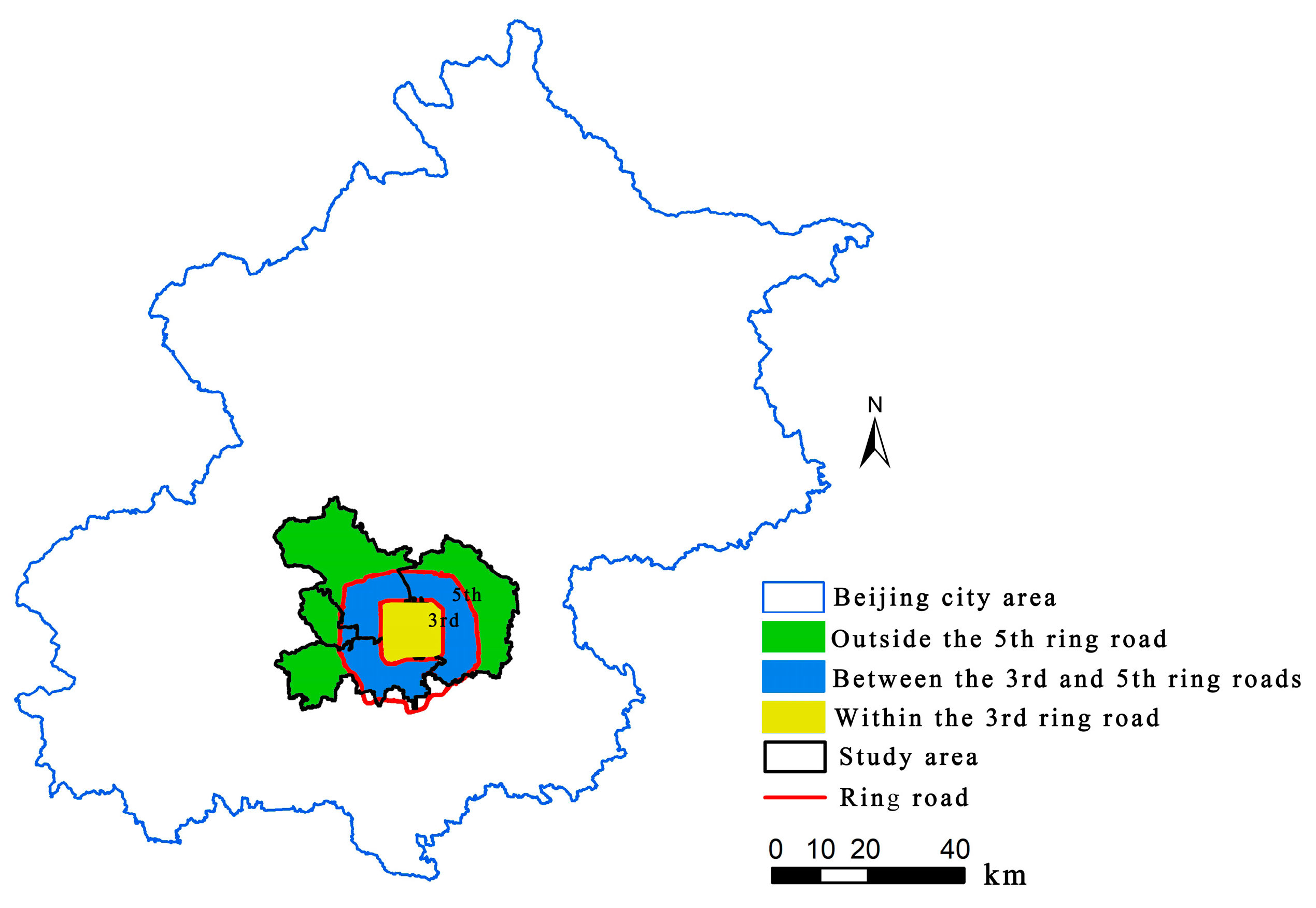
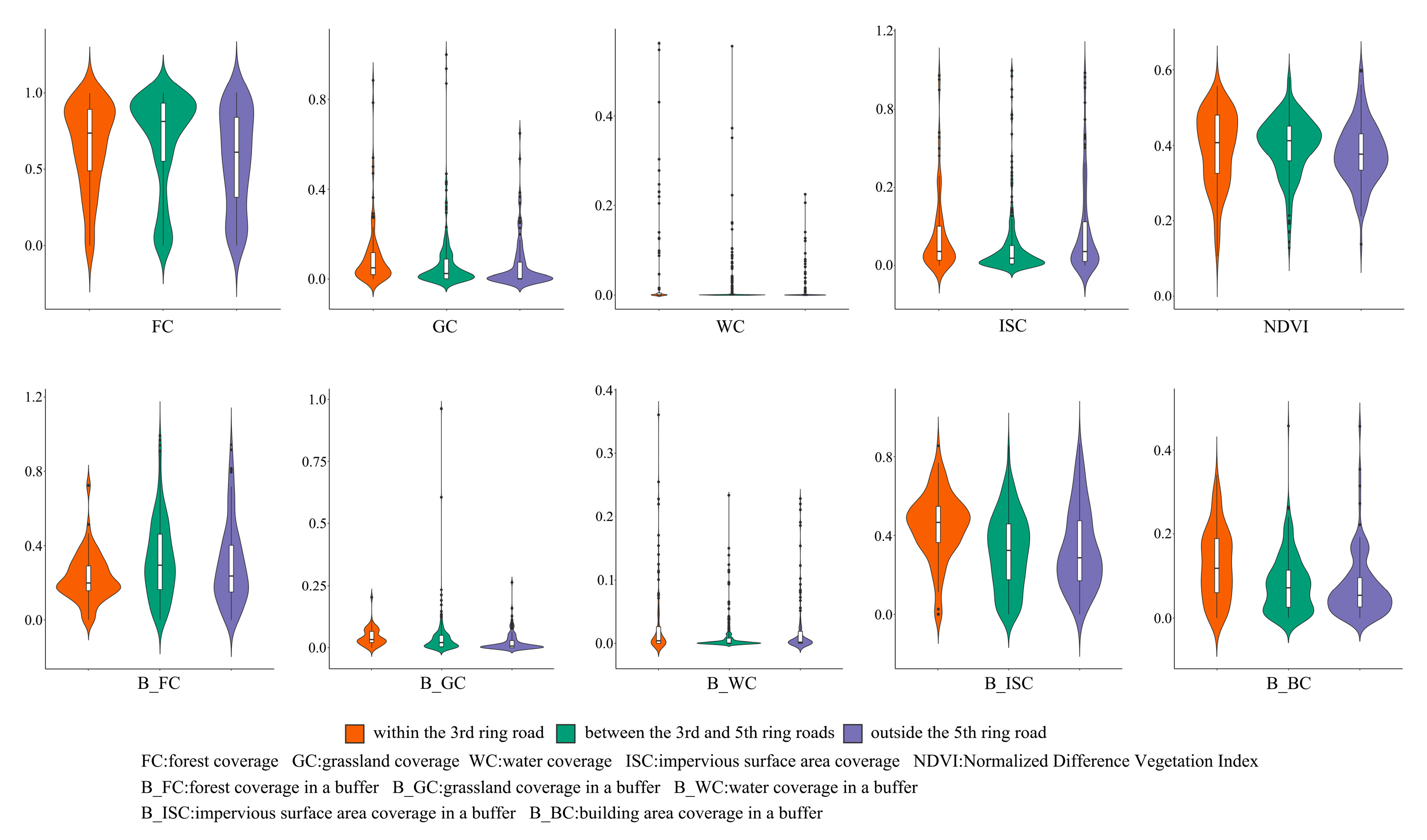
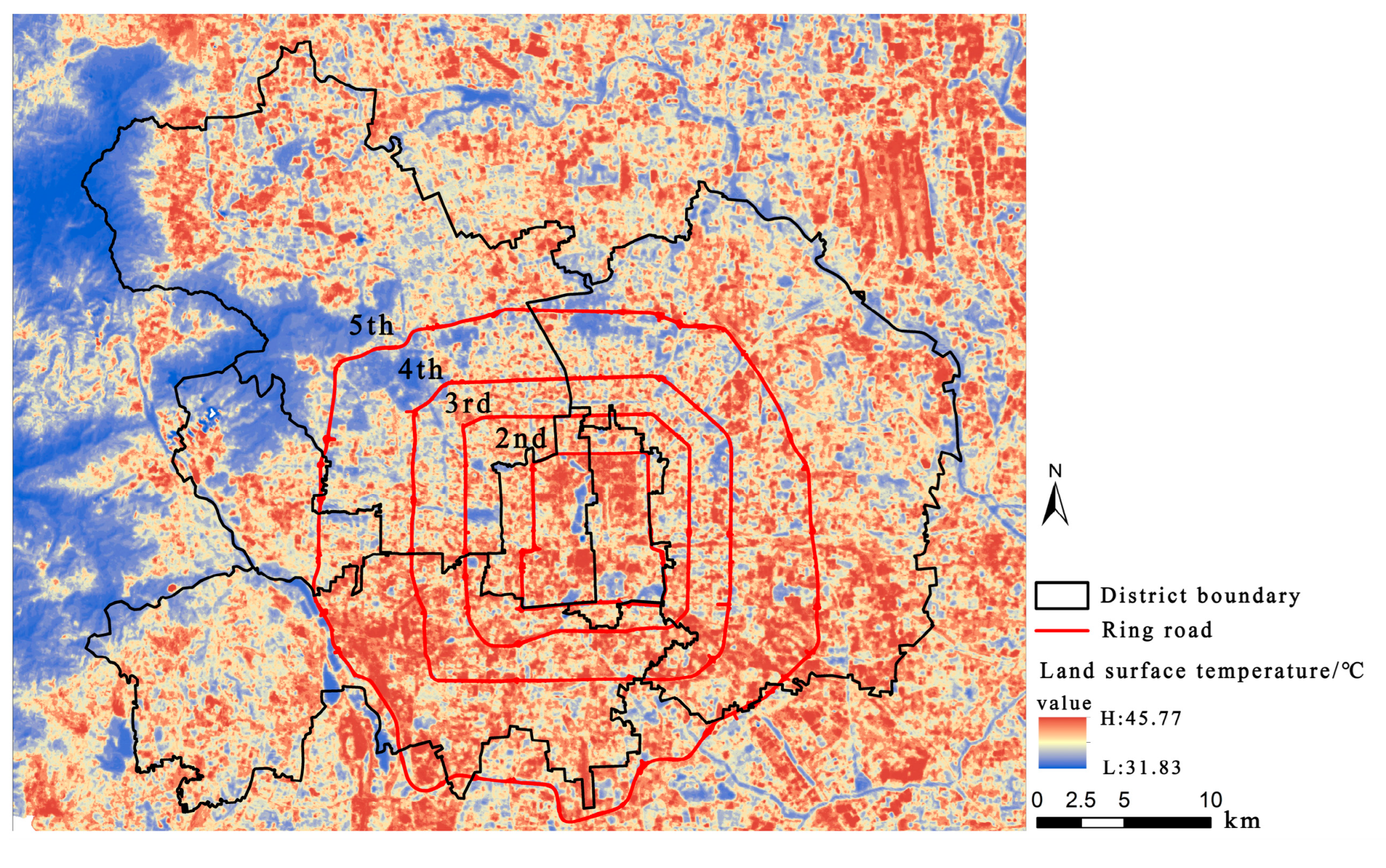


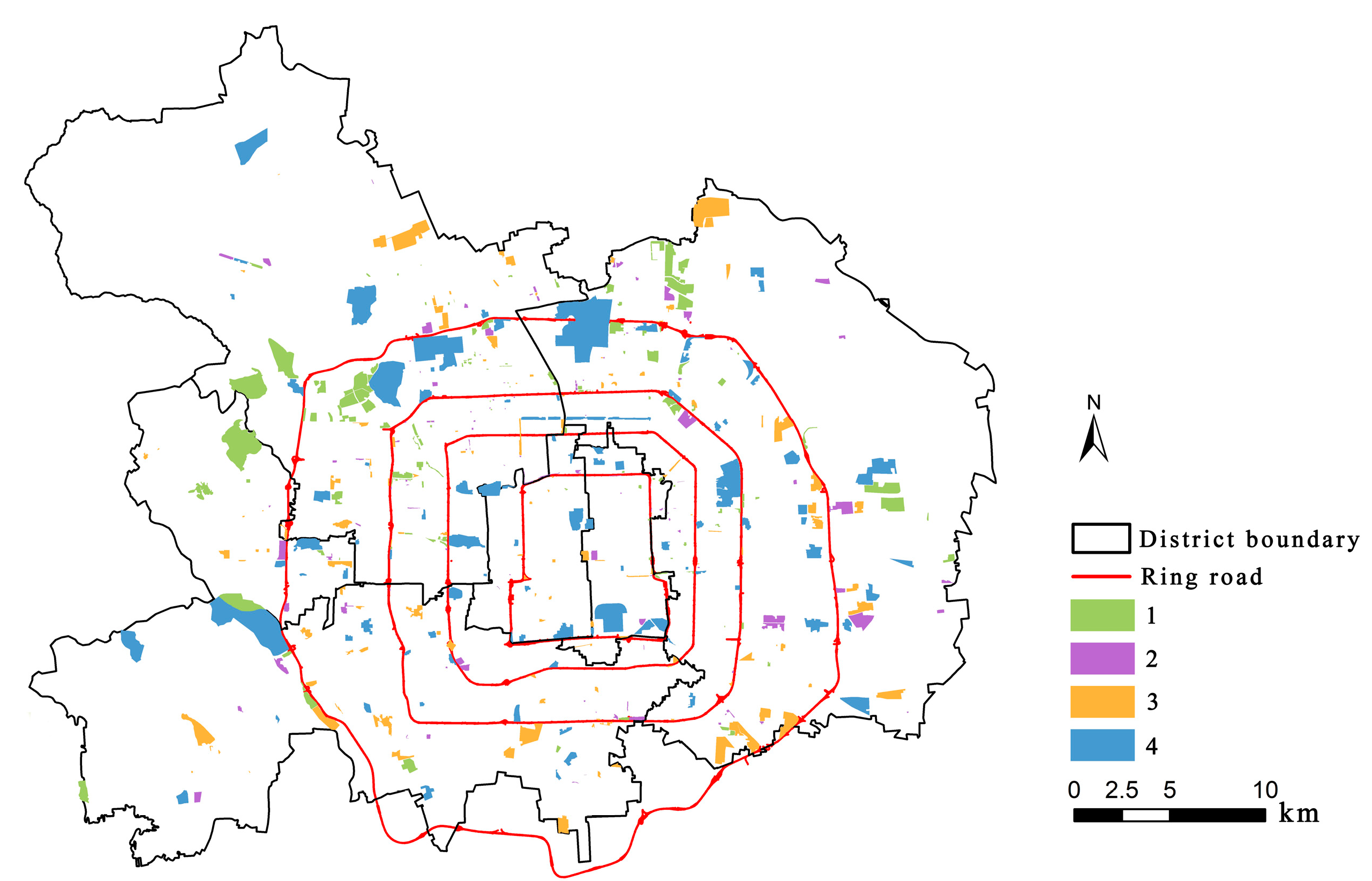
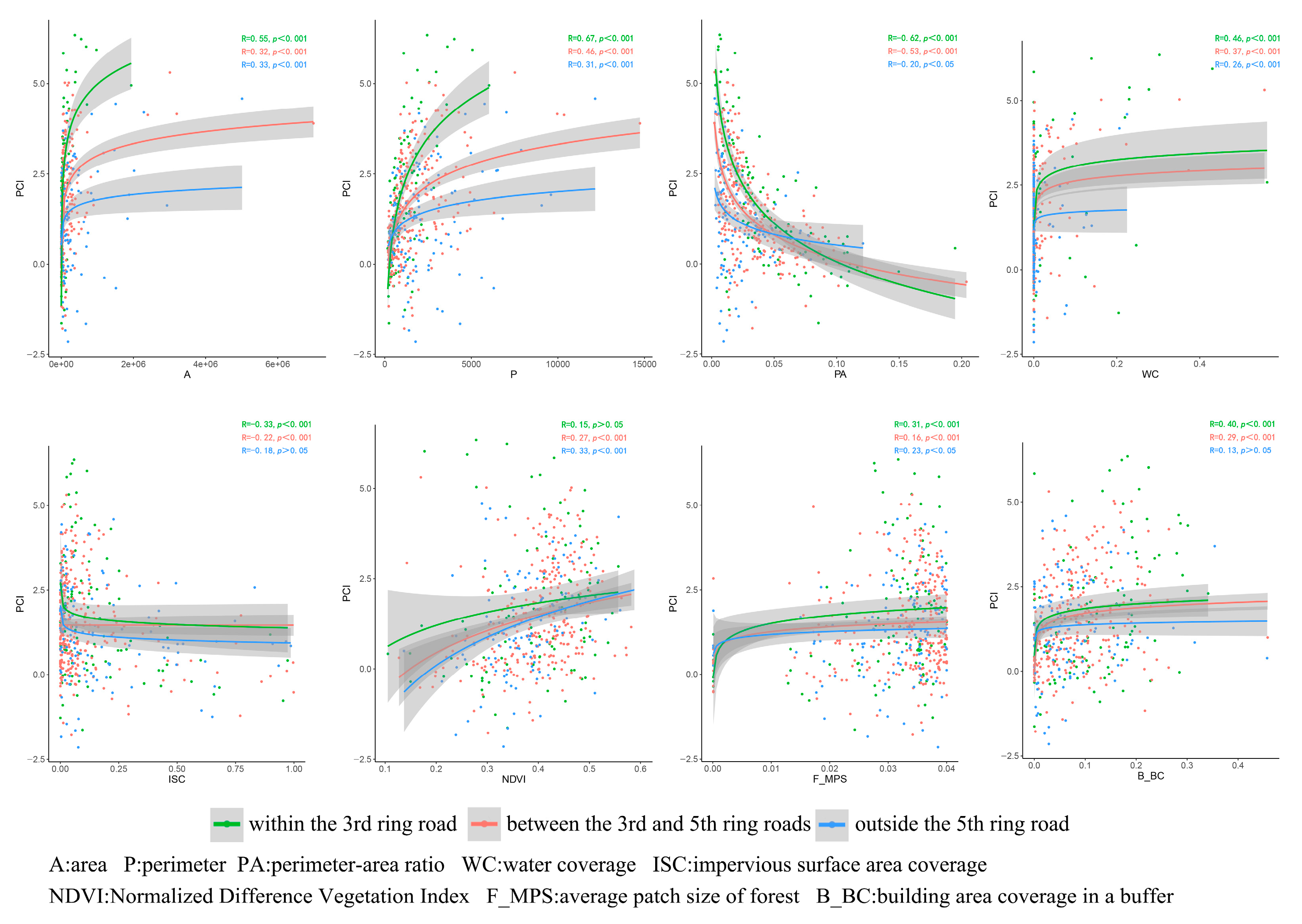

| Research Data | Types | Sources |
|---|---|---|
| Landsat 8 OLI_TIRS satellite imagery | Raster data (30 m) | USGS http://earthexplorer.usgs.gov/ (accessed on 14 June 2021) |
| Remote sensing imagery | Raster data | GF-2 |
| Land use data | Raster data (4 m) | Derived from GF-2 satellite imagery |
| Park boundary data | Shapefile | AOI in Baidu Map, Beijing Municipal Forestry and Parks Bureau |
| LST data | Raster data (30 m) | Derived from Landsat satellite imagery |
| NDVI | Raster data (30 m) | Derived from Landsat satellite imagery |
| Ring road data | Shapefile | Open Street Map (OSM) |
| Indicator (Abbreviation) | Description | Unit | Calculation Method |
|---|---|---|---|
| Area (A) | Area of a park | ha | Geometric statistics calculation in ArcGIS 10.6 |
| Perimeter (P) | Total perimeter of a park | m | Geometric statistics calculation in ArcGIS 10.6 |
| Perimeter–area ratio (PA) | Overall compactness of a park | Dimensionless | |
| NDVI | Vegetation condition within a park | Dimensionless | and represent the pixel values of the near-infrared band and the red band, respectively |
| Forest coverage (FC) | Percentage of forest cover in a park | % | |
| Grassland coverage (GC) | Percentage of grassland cover in a park | % | |
| Water coverage (WC) | Percentage of water cover in a park | % | |
| Impervious surface area coverage (ISC) | Percentage of impervious surface area in a park | % | |
| Average patch size of forest (F_MPS) | Average size of forest patches in a park | ha | Calculation using Fragstats 4.2 |
| Forest coverage in a buffer (B_FC) | Percentage of forest cover in a buffer | % | |
| Grassland coverage in a buffer (B_GC) | Percentage of grassland cover in a buffer | % | |
| Water coverage in a buffer (B_WC) | Percentage of water cover in a buffer | % | |
| Impervious surface area coverage in a buffer (B_ISC) | Percentage of impervious surface area in a buffer | % | |
| Building area coverage in a buffer (B_BC) | Percentage of building area in a buffer | % |
| °C | 3 | 3–5 | 5 | |
|---|---|---|---|---|
| LSTP | Average value | 42.24 | 42.01 | 42.36 |
| Median value | 42.35 | 42.09 | 42.33 | |
| LSTB | Mean value | 43.72 | 43.09 | 43.19 |
| Median value | 43.92 | 43.26 | 43.48 |
| Type | Cluster Center | Characteristic | 3 | 3–5 | 5 | Total | ||
|---|---|---|---|---|---|---|---|---|
| PCI | LSTP | LSTB | ||||||
| 1 | 0.33 | 0.47 | 0.48 | The cold island effect is weak, with lower temperatures observed both within the park and in the buffer zone. | 17 | 92 | 34 | 143 |
| 2 | 0.32 | 0.88 | 0.86 | The cold island effect is weak, with high temperatures observed both within the park and in the buffer zone. | 33 | 62 | 26 | 121 |
| 3 | 0.49 | 0.65 | 0.75 | The cold island effect is moderate, with relatively high temperatures observed both within the park and in the buffer zone. | 24 | 71 | 38 | 133 |
| 4 | 0.73 | 0.40 | 0.74 | The cold island effect is strong, with lower temperatures observed within the park and higher temperatures in the buffer zone. | 27 | 51 | 18 | 96 |
| Non-Standardized Coefficient | p | R2 | F | ||
|---|---|---|---|---|---|
| B | |||||
| 3 | Constant | 5.262 | 0.000 ** | 0.681 | F = 31.206, p = 0.000 |
| P | 0.001 | 0.000 ** | |||
| PA | −21.200 | 0.000 ** | |||
| ISC | −4.758 | 0.000 ** | |||
| B_FC | −3.176 | 0.001 ** | |||
| B_BC | 3.096 | 0.025 * | |||
| F_MPS | 72.813 | 0.001 ** | |||
| GC | −2.325 | 0.014 * | |||
| 3–5 | Constant | −0.884 | 0.003 ** | 0.580 | F = 48.424, p = 0.000 |
| PA | −13.341 | 0.000 ** | |||
| WC | 9.101 | 0.000 ** | |||
| NDVI | 5.677 | 0.000 ** | |||
| B_ISC | 1.648 | 0.000 ** | |||
| ISC | −1.782 | 0.000 ** | |||
| B_FC | −1.049 | 0.000 ** | |||
| B_BC | 1.883 | 0.043 * | |||
| 5 | Constant | −1.727 | 0.004 ** | 0.264 | F = 11.230, p = 0.000 |
| NDVI | 6.404 | 0.000 ** | |||
| WC | 10.386 | 0.002 ** | |||
| B_BC | 3.840 | 0.012 * | |||
| A | 4.286 × 10−7 | 0.022 * | |||
| PCI | |||
|---|---|---|---|
| 3 | 3–5 | 5 | |
| A | 0.546 ** | 0.319 ** | 0.327 ** |
| P | 0.670 ** | 0.459 ** | 0.313 ** |
| PA | −0.623 ** | −0.531 ** | −0.206 * |
| NDVI | 0.150 | 0.269 ** | 0.327 ** |
| FC | 0.119 | 0.026 | 0.151 |
| GC | −0.147 | −0.080 | −0.118 |
| WC | 0.458 ** | 0.368 ** | 0.256 ** |
| ISC | −0.332 ** | −0.220 ** | −0.178 |
| F_MPS | 0.312 ** | 0.158 ** | 0.228 * |
| F_SI | 0.175 | 0.154 * | 0.050 |
| F_PD | −0.270 | 0.029 | −0.142 |
| B_FC | 0.030 | −0.131 * | 0.061 |
| B_GC | −0.215 * | −0.013 | −0.127 |
| B_WC | −0.117 | 0.014 | −0.167 |
| B_ISC | −0.132 | 0.205 ** | 0.046 |
| B_BC | 0.405 ** | 0.291 ** | 0.133 |
Disclaimer/Publisher’s Note: The statements, opinions and data contained in all publications are solely those of the individual author(s) and contributor(s) and not of MDPI and/or the editor(s). MDPI and/or the editor(s) disclaim responsibility for any injury to people or property resulting from any ideas, methods, instructions or products referred to in the content. |
© 2024 by the authors. Licensee MDPI, Basel, Switzerland. This article is an open access article distributed under the terms and conditions of the Creative Commons Attribution (CC BY) license (https://creativecommons.org/licenses/by/4.0/).
Share and Cite
Xu, C.; Wang, W.; Zhu, H. Spatial Gradient Differences in the Cooling Island Effect and Influencing Factors of Urban Park Green Spaces in Beijing. Buildings 2024, 14, 1206. https://doi.org/10.3390/buildings14051206
Xu C, Wang W, Zhu H. Spatial Gradient Differences in the Cooling Island Effect and Influencing Factors of Urban Park Green Spaces in Beijing. Buildings. 2024; 14(5):1206. https://doi.org/10.3390/buildings14051206
Chicago/Turabian StyleXu, Chao, Wenjing Wang, and He Zhu. 2024. "Spatial Gradient Differences in the Cooling Island Effect and Influencing Factors of Urban Park Green Spaces in Beijing" Buildings 14, no. 5: 1206. https://doi.org/10.3390/buildings14051206




